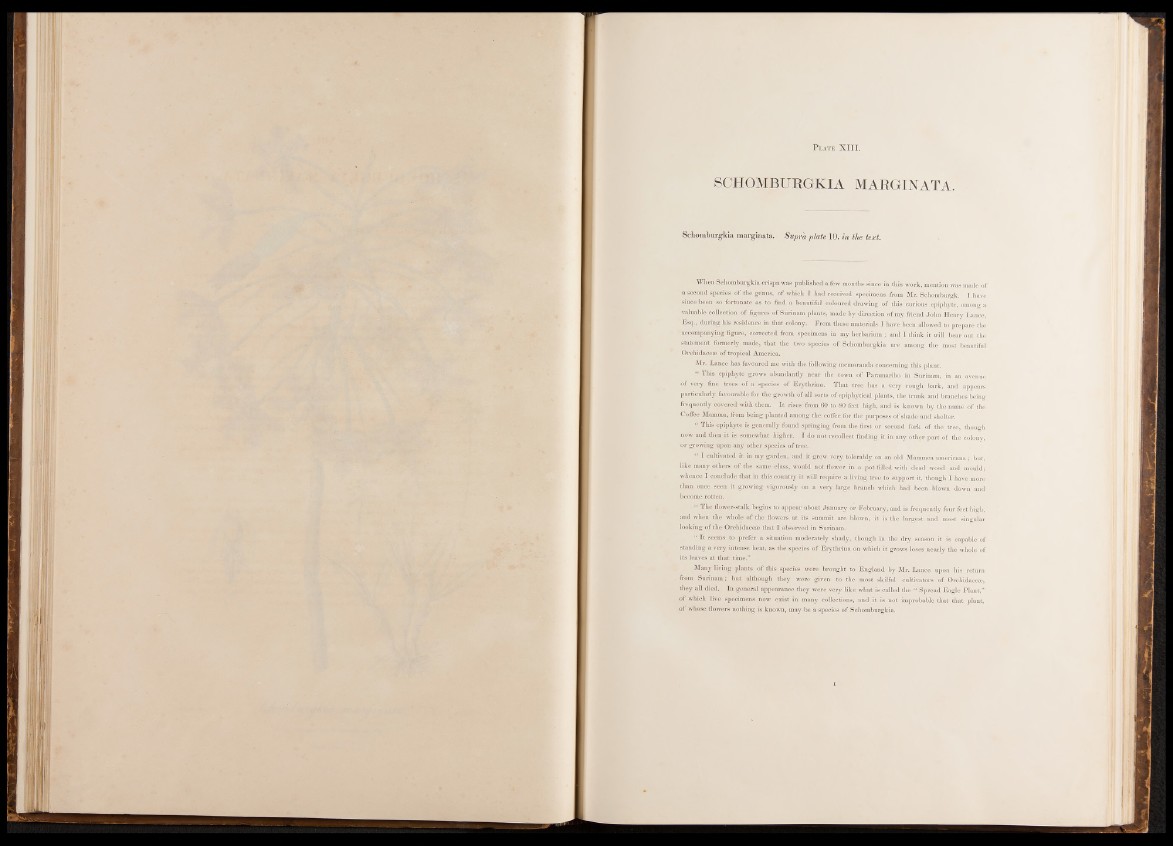
P late XIII.
SCHOMBURGKIA MARGINATA.
Schomburgkia marginata. Supra plate 10. in the text.
When Schomburgkia crispa was published a few months since in this work, mention was made of
a second species of thé genus, of which I had received specimens from Mr. Schomburgk. I have
since been so fortunate as to find a beautiful coloured drawing of this curious epiphyte, among a
valuable collection of figures of Surinam plants, made by direction of my friend John Henry Lance,
Esq., during his residence in that colony. From these materials I have been allowed to prepare the
^accompanying figure, corrected from specimens in my herbarium ; and I think it will bear out the
statement formerly made, that the two species of Schomburgkia are among the most beautiful
Orchidaceee of tropical America.
Mr. Lance has favoured me with the following memoranda concerning this plant.
“ This epiphyte grows abundantly near the town of Paramaribo in Surinam, in an avenue
of very fine trees of a species of Erythrina. That tree has a very rough bark, and appears
particularly favourable for the growth of all sorts of epiphytical plants, the trunk and branches being
frequently covered with them. It risés from 60 to 80 feet high, and is known by the name of the
Coffee Mamma, from being planted among the coffee for the purposes of shade and shelter.
“ This epiphyte is generally found springing from the first or second fork)of the tree, though
now and then it is somewhat higher. I do not recollect finding it in any other part of the’ colony,
or growing upon any other species of tree.
I cultivated it in my garden, and it grew very tolerably on an old Mammea americana; but,
like many others of the same class, would not flower in a pot filled with dead wood and mould;
whence I conclude that in this country it will require a living tree to support it, though I have more
th^.n once seen it growing vigorously on a very large branch which had been blown down and
. become rotten.
The flower-stalk begins to appear about January or February, and is frequently four feet high,
and when the whole of the flowers at its summit are blown, it is the largest and most singular
looking of the Orchidaceee that I observed in Surinam.
“ It seems to prefer a situation moderately shady, though in the dry season it is capable of
standing a very intense heat, as the species of Erythrina on which it grows loses nearly the whole of
its leaves at that time.”
Many living plants of this species were brought to England by Mr. Lance upon his return
from Surinam; but although they were given to the most skilful cultivators of Orchidaceee,
they all died. In general appearance they were very like what is called the “ Spread Eagle Plant,”
of which live specimens now exist in many collections, and it is not improbable that that plant,
of whose flowers nothing is known, may be a species of Schomburgkia.